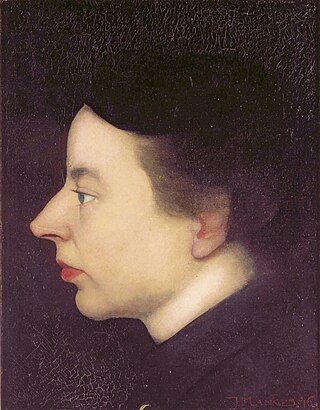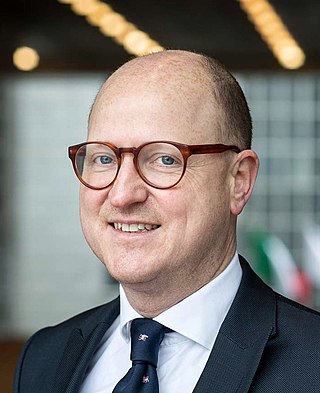Related Research Articles

Albert Einstein was a German-born theoretical physicist who is widely held to be one of the greatest and most influential scientists of all time. Best known for developing the theory of relativity, Einstein also made important contributions to quantum mechanics, and was thus a central figure in the revolutionary reshaping of the scientific understanding of nature that modern physics accomplished in the first decades of the twentieth century. His mass–energy equivalence formula E = mc2, which arises from relativity theory, has been called "the world's most famous equation". He received the 1921 Nobel Prize in Physics "for his services to theoretical physics, and especially for his discovery of the law of the photoelectric effect", a pivotal step in the development of quantum theory. His work is also known for its influence on the philosophy of science. In a 1999 poll of 130 leading physicists worldwide by the British journal Physics World, Einstein was ranked the greatest physicist of all time. His intellectual achievements and originality have made the word Einstein broadly synonymous with genius.

Delft is a city and municipality in the province of South Holland, Netherlands. It is located between Rotterdam, to the southeast, and The Hague, to the northwest. Together with them, it is a part of both the Rotterdam–The Hague metropolitan area and the Randstad.

A photon is an elementary particle that is a quantum of the electromagnetic field, including electromagnetic radiation such as light and radio waves, and the force carrier for the electromagnetic force. Photons are massless, so they always move at the speed of light when in vacuum, 299792458 m/s. The photon belongs to the class of boson particles.

The Rijksmuseum is the national museum of the Netherlands dedicated to Dutch arts and history and is located in Amsterdam. The museum is located at the Museum Square in the borough of Amsterdam South, close to the Van Gogh Museum, the Stedelijk Museum Amsterdam, and the Concertgebouw.

Peter Joseph William Debye was a Dutch-American physicist and physical chemist, and Nobel laureate in Chemistry.

Henricus Antonius "Han" van Meegeren was a Dutch painter and portraitist, considered one of the most ingenious art forgers of the 20th century. Van Meegeren became a national hero after World War II when it was revealed that he had sold a forged painting to Reichsmarschall Hermann Göring during the Nazi occupation of the Netherlands.

Joseph Marie Antoine Hubert Luns was a Dutch politician of the defunct Catholic People's Party (KVP), now merged into the Christian Democratic Appeal (CDA), diplomat, and jurist. He served as Secretary General of NATO from 1 October 1971 until 25 June 1984.

Hendrik Antoon Lorentz was a Dutch physicist who shared the 1902 Nobel Prize in Physics with Pieter Zeeman for the discovery and theoretical explanation of the Zeeman effect. He derived the Lorentz transformation of the special theory of relativity, as well as the Lorentz force, which describes the combined electric and magnetic forces acting on a charged particle in an electromagnetic field. Lorentz was also responsible for the Lorentz oscillator model, a classical model used to describe the anomalous dispersion observed in dielectric materials when the driving frequency of the electric field was near the resonant frequency, resulting in abnormal refractive indices.

The Pugwash Conferences on Science and World Affairs is an international organization that brings together scholars and public figures to work toward reducing the danger of armed conflict and to seek solutions to global security threats. It was founded in 1957 by Joseph Rotblat and Bertrand Russell in Pugwash, Nova Scotia, Canada, following the release of the Russell–Einstein Manifesto in 1955.

Femke Halsema is a Dutch politician and filmmaker. On 27 June 2018, she was appointed Mayor of Amsterdam and began serving a six-year term on 12 July 2018. She is the first woman to hold the position on a non-interim basis. She previously was a member of the House of Representatives for the leftist green party GroenLinks from 1998 to 2011, and served as the party's parliamentary leader from 2002 to 2010.

Arnon Yasha Yves Grunberg is a Dutch writer of novels, essays, and columns, as well as a journalist. He published some of his work under the heteronym Marek van der Jagt. He lives in New York. His work has been translated into 30 languages. In 2022 he received the PC Hooftprijs, a Dutch literary lifetime achievement award. His most acclaimed and successful novels are Blue Mondays and Tirza. The New York Times called the latter ‘grimly comic and unflinching (…) while not always enjoyable, it is never less than enthralling’. Frankfurter Allgemeine Zeitung described him as ‘the Dutch Philip Roth’.

Louis "Loe" de Jong was a Dutch historian who specialised in the Netherlands in World War II and the Dutch resistance.

Wander Johannes de Haas was a Dutch physicist and mathematician. He is best known for the Shubnikov–de Haas effect, the De Haas–Van Alphen effect and the Einstein–de Haas effect.

The Dutch resistance to the German occupation of the Netherlands during World War II can be mainly characterized as non-violent. The primary organizers were the Communist Party, churches, and independent groups. Over 300,000 people were hidden from German authorities in the autumn of 1944 by 60,000 to 200,000 illegal landlords and caretakers. These activities were tolerated knowingly by some one million people, including a few individuals among German occupiers and military.

Albert Verwey was a Dutch poet belonging to the "Movement of Eighty". As a translator, staffer, and literary historian he played an important role in the literary life of The Netherlands in the late 19th and early 20th centuries.

Geertruida Wijsmuller-Meijer was a Dutch resistance fighter who brought Jewish children and adults into safety before and during the Second World War. Together with other people involved in the pre-war Kindertransport, she saved the lives of more than 10,000 Jewish children, fleeing anti-Semitism. She was honored as Righteous among the Nations by Yad Vashem. After the war she served on the Amsterdam city council.
The Joint Sigint Cyber Unit (JSCU) is a Dutch government organisation, which was founded in 2013 and became operational on June 15, 2014. JSCU's primary tasks are intercepting radio and satellite traffic (Sigint) and obtaining intelligence through cyber-operations. The organisation cooperates closely with allied foreign intelligence agencies.

Anne Zernike (1887–1972) was a Dutch, liberal theologian, who was the first ordained woman minister of the Netherlands. Though she began her career with the Mennonites, which was the only congregation that allowed female ministers at the time, the majority of her career was spent in the Dutch Protestant Association (NPB).

Bart Groothuis is a Dutch politician serving as a Member of the European Parliament (MEP) since 2020. He is a member of the Dutch conservative-liberal People's Party for Freedom and Democracy (VVD) and the Alliance of Liberals and Democrats for Europe Party, which are both part of the European political group Renew Europe.

Petrus Johannes "Peter" Valstar is a Dutch politician of the conservative liberal People's Party for Freedom and Democracy (VVD). He worked as a press officer for the VVD, as the political assistant of Minister Jeanine Hennis-Plasschaert and Prime Minister Mark Rutte, and as a spokesperson at the Ministry of Defence before being elected to the House of Representatives in March 2021.
References
- 1 2 "Dr. Sybe Izaak Rispens". Connect6. Retrieved 21 July 2015.
- ↑ Rispens, Sybe Izaäk (2005). Machine Reason: A History of Clocks, Computers and Consciousness. ISBN 9789036724104.
- ↑ Vermeer, Bram. "Bram Vermeer Journalistiek". Vermeer. Retrieved 21 July 2015.
- 1 2 Rispens, Sybe (2006). Einstein in Nederland. Een intellectuele biografie . Ambo/Anthos. ISBN 90-263-1903-7.
- ↑ Rispens, Sybe; Vermeer, Bram; den Hond, Bas; Kwaaitaal, Jacco (2010). The Communication Revolution: New Perspectives on Photonics. COBRA, Inter-University Research School on Communication Technologies Basic Research and Applications. ISBN 978-9038621555.
- ↑ "Nobel laureate loses honors over Nazi links". sptimes. St. Petersburg Times. Retrieved 21 July 2015.
- ↑ Ball, Philip (Oct 20, 2014). Serving the Reich: The Struggle for the Soul of Physics Under Hitler. University of Chicago Press. p. 303. ISBN 978-0226204574.
- ↑ Max, Arthur. "Dutch Schools Strip Nobel Laureate's Name". apnewsarchive. Associated Press. Retrieved 21 July 2015.
- ↑ Ball, Phillip. "The Year of Chemistry (but some physics and biology too)". homunculus: January 2011. Retrieved 21 July 2015.
- ↑ Abruña, Héctor; Chamot, Emile. "Decision CORNELL UNIVERSITY". Wayback Machine. Cornell University. Archived from the original on January 9, 2007. Retrieved 21 July 2015.
{{cite web}}: CS1 maint: unfit URL (link) - ↑ Eickhoff, Martijn. "In naam der wetenschap? P.J.W. Debye en zijn carrière in nazi - Duitsland". NIOD. Nederlands Instituut voor Oorlogsdocumentatie. Retrieved 21 July 2015.[ permanent dead link ]